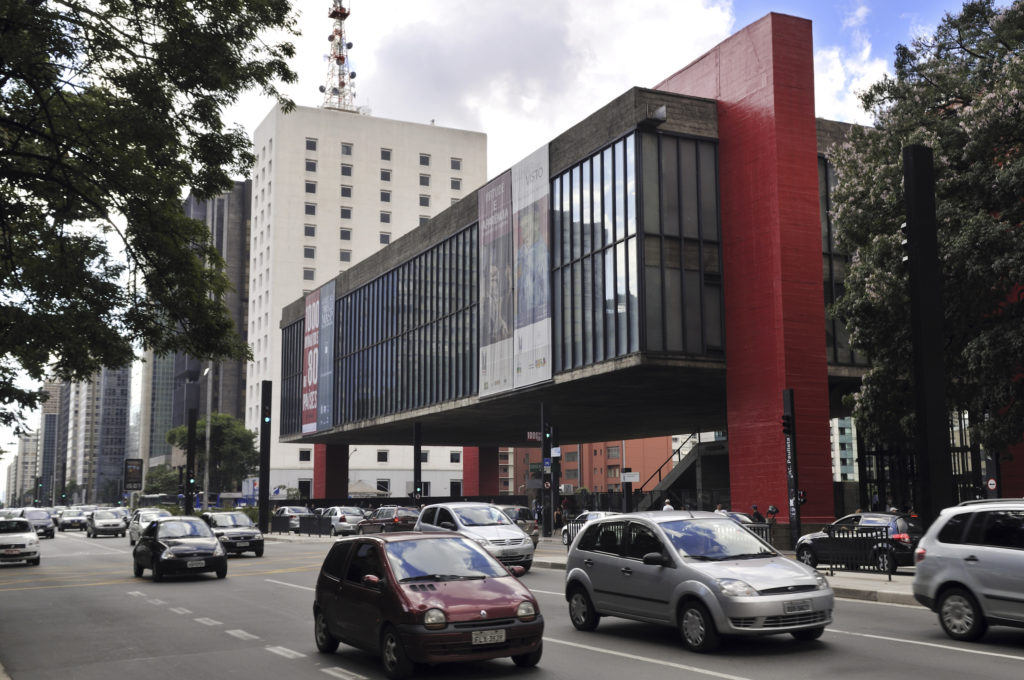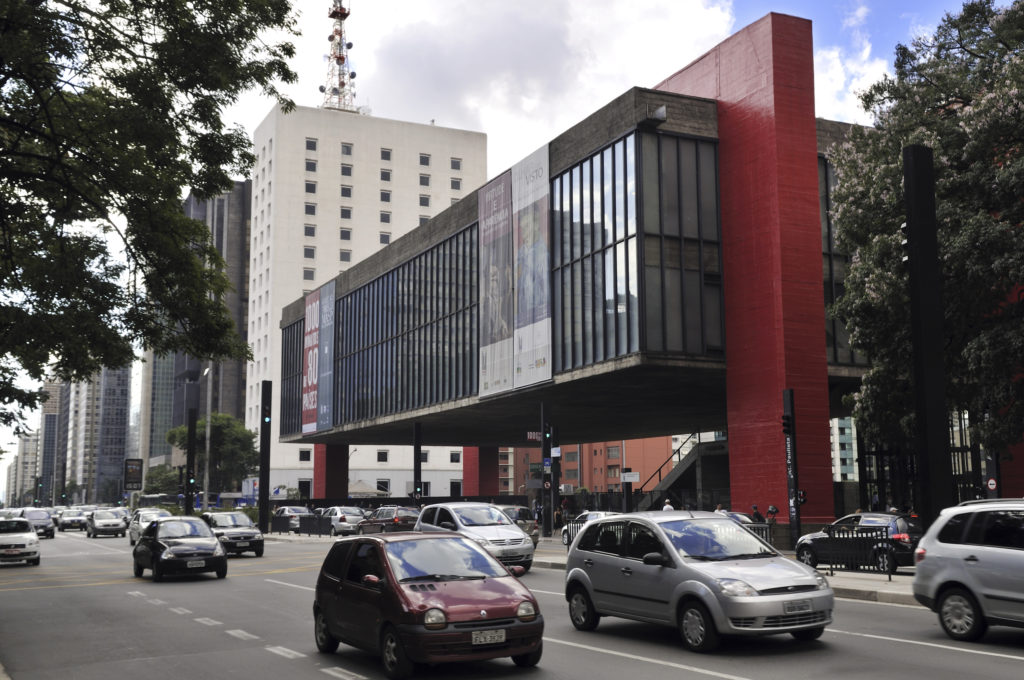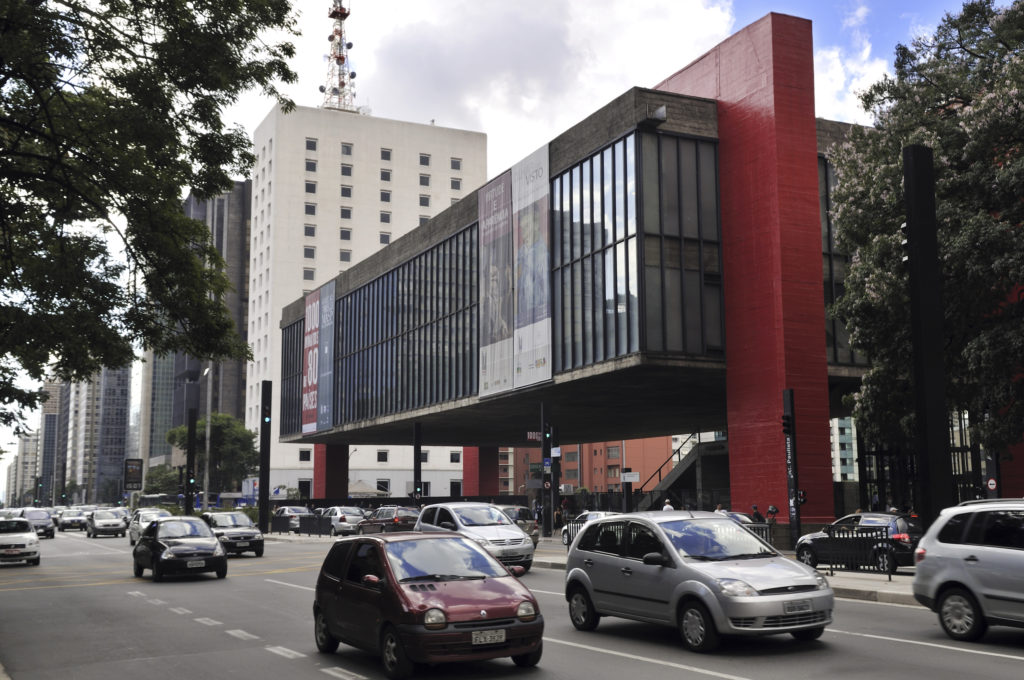[ad_1]

The Museu de Arte de São Paulo.
IMAGEBROKER/REX/SHUTTERSTOCK
Currently on view at the Museu de Arte de São Paulo is a retrospective for Lina Bo Bardi, the Italian-born architect who designed the museum. Though the show covers the breadth of her career, the MASP exhibition is, in part, a tribute to the museum’s history. With this in mind, we’ve republished an essay by Bo Bardi’s husband and MASP’s founding director, P. M. Bardi, about the museum that appeared in the March 1957 issue of ARTnews. It was written on the occasion of a loan of works from the museum to the Metropolitan Museum of Art in New York. While the terminology Bardi uses is dated (in some places he uses “America” to refer to all of North and South America, and he employs language that today might be considered derogatory to describe indigenous communities), his points about MASP’s status within Brazil remain salient. Noting that the Met show is a “minor event” for New Yorkers, he writes that it could lead to “closer relations in cultural matters.” His essay follows below. —Alex Greenberger
“Building a museum on virgin soil”
By P. M. Bardi
March 1957
How São Paulo’s dynamic new museum, now lending a group of important pictures to the Metropolitan, was founded and built an audience
A new museum has been created in Brazil. This is a limitless, undiscovered country, whose impenetrable forests and great rivers present obstacles to the would-be explorer that pull him up sharply at what is, in fact, the very starting-point of art: an immense chaos of natural beauty which holds in its depths an elusive population of Indians whose art is still in the prehistoric stage. Manet had visited the country as a sailor in his youth, but had prudently kept to the streets of Rio de Janeiro—and in any case these were scenes for a Gauguin. This explains why Gauguin’s Poor Fisherman of Tahiti is one of the favorite pictures of our Museum, as is Cézanne’s Negro Scorpion, in which the artist is still enamored of Ribera in his gloomiest mood. But to return to Brazil. In a few of the large modern cities there are still vestiges of the Iberian Baroque, with its turbulent and disordered volutes that would seem to be some nightmare imposition of the Counter-Reformation on the colonies while they were being contested by the Spanish and the Dutch. The Jesuits built cities: some are now flourishing, others have been engulfed by the forest; the Benedictines and Franciscans built superb churches; craftsmen colored miles of walls with Old and New Testament subjects. But in the South American colonies there was only one true use for gold—export to the monarchs of Europe.
Before Brazil achieved independence in the latter half of the nineteenth century, the country had become the refuge of the royal family of Portugal, deprived of their dominions in Europe by Napoleon. These monarchs had felt it incumbent upon themselves to do something for art and culture, and an Artistic Mission, consisting of Bonapartists who had lost their jobs after Waterloo, was summoned to the country in 1816. But the enterprise was a failure. Politics, the mentality of large landowners, the rapacity of colonial adventurers and ignorance are no friends of the Muses. It was a young country—and a Latin country. When Goethe sent his works to Harvard University with the famous dedication to “that wonderful country that draws upon itself the attention of the whole world,” Brazil had still to begin. It was only towards the end of the century that culture began to show itself, and then, too frequently, it tried to carry on from points reached in older countries, omitting all historical background. But there was a wave of enthusiasm for art and poetry, and in the present century the writing of verse after the Parnassians, the imitation of the Pompierisme of the Paris Salons, the rehashing of the ornate architecture of Portuguese origin, gave place to poetry and other activities of an independent and markedly regional character. Niemeyer the architect, Portinari the painter, Manoel Bandeira the poet and Villa Lobos the musician are now names of international fame. All this was the result of a movement, after the first World War, whose presiding genius was that of F. T. Marinetti, and whose adepts were frequent visitors to Paris, where they proclaimed themselves “children of a virgin soil” or, jestingly, “Anthropophagists.” “Why look to Rome?” they exclaimed. “Haven’t we plenty of mystique here at home?”
But nobody ever mentioned museums. Not that they didn’t exist, but they were only custodians of a dusty mummy or two and a few dubious paintings that had belonged to the Portuguese court. The enterprise of founding a museum that would be a challenge as well as a cultural institution was solely that of Senator Assis Chateaubriand, direct and proprietor of the newspaper, radio and television syndicate, Diarios Associados. The person who was charged with actually creating the museum had to take into consideration the fact that São Paulo, with its two and a half million inhabitants, was, for his purposes, a virgin town. Art and culture, and all the adventures of intellect, require the patience insisted on by Leonardo, and humility must accompany every step. The enthusiastic spirits that wanted to save time by starting where others had left off had to be curbed; and it was particularly necessary to oppose the facile idea of a “museum of modern art” which could have become an easy success and would have encouraged the type who knows the answer to the $64,000 question on Picasso but has never heard of Beato Angelico.
The São Paulo Museum proclaimed that art meant the history of art, without limit of time or place, with an implied antipathy for the lazy academics and neo-academics, and a welcome for whoever dared to advance original ideas provided they were backed by clear thought and sincerity. Art snobbery had no place in our plans (though we made use of this necessary evil, which one must be able to manage with tact and ability, to enrich our collections). The Museum was thus born on a polemical issue, and stood in favor of a virgin clientèle recruited from the young, for whom schools were opened in the Museum itself in which theoretical and practical instruction was given in all the arts. In this we were following the example of many institutions in the U.S. Museography was not, for us, merely a question of conservation (though the location in a tropical country raised new problems in this field as well), but also one of creating a public.
Without some new approach no one would have come to admire the picture collection which was rapidly being built up through the patronage of Mr. Chateaubriand, who recruited his numerous friends, obtained the support of the municipality, and the State and Federal governments. He also had the idea of using publicity methods for increasing the Museum’s collections: to celebrate the acquisition of new paintings, receptions were given in some of the finest houses of Rio and São Paulo, even in foreign legations and embassies, and occasionally on outlying fazendas, which the precious cargoes of Rembrandts, Frans Hals and Degas reached after long hours of flight over impenetrable forests. Without the journalist’s flair, energy and the public spirit of this man (who once bought a thousand aircraft to present to his country’s flying clubs), the Museum of São Paulo would not exist.
The Museum originated nine years ago as a small studio in which courses on art history were given, and the first few original works of art were shown to the group of students who were to become the protoplasm of the museum-idea; and as we look back we now can see clearly some of the mistakes that were made. The principal error, in spite of so much enterprise and confidence, was the failure to calculate the rate at which various ideas could be developed, and we often found them being overtaken by others to which less thought had been given. The craze for modernity which broke out in the form of an overwhelming urge to participate in contemporary art, rather than study the art of the past, created a particular atmosphere, and led to the organization of the São Paulo biennial, exhibitions which brought the contemporary production of the whole world to the notice of a public that was beginning to take a keen interest in these matters and had already got to know something of modern art, from Picasso, Matisse, Rouault, Miró and Chagall, down to Wols and Magnelli.
The Museum’s basic intention is to offer an historical panorama of the arts, but not in a rigidly schematic manner. In our picture gallery, van Gogh keeps company with Tintoretto, Toulouse-Lautrec with Lipchitz: elements of harmony and contrast are thus put in evidence, characteristics and manners are commented on in an atmosphere cordially helpful to the visitor. The Museum is fundamentally didactic: its purpose is to teach. There is a large hall which houses didactic exhibitions on art history, covering longer or shorter periods, or even dealing with special problems, according to requirements. For example, an exhibition of modern art was accompanied by a didactic exhibition on the history of the abstract in art, which included “abstract” masterpieces of Mesopotamia, Egypt and Greece, and, of course, of the Pre-Columbian art of America, from Mexico to Marajoan art of Brazil which flourished around the mouth of the Amazon. The public was both entertained and instructed, even if the panels of our didactic exhibitions are little more than text books. But they are compiled in a precise, easily understood manner, without any of the abstruse terminology of modern criticism. One of the didactic exhibitions dealt with the place of the artist within society: the artist’s vision and intuition, his function of giving expression to the life of a nation, his concern with the whole of man’s moral being. Here again the motive was to teach, for we are persuaded that the function of a museum is to co-operate, divulge and make things clear. Sometimes an exhibition had a frankly polemical purpose, as a reply, for example, to the newspaper pundits who (even sincerely) maintained that Brazilians had nothing to learn from Michelangelo.
Virgin soil also signifies ground on which splendid flowers and coarsest grasses grow together, but it is all uncultivated vegetation, and there must be no loss of patience, even in the delicate task of curbing the competition of weeds. How numerous are the duties of a museum director who does not have the luck to live in a city that has been built up through the centuries by the miracle of history, with its architecture and art, its museums and libraries, and the local connoisseurs who keep alive the love for the masters of the past! Certainly we should have liked to have been able to discuss with our European colleagues the riddle of Mantegna’s St. Jerome which is now at São Paulo, and which the critics have attributed at various times to Gianbellino, Marco Zoppo and, more recently, even to Benaglio. Expertising is a pleasing pastime, a kind of chess in which instinct and intelligence are exercised by the subtlest problems. But the poor director of a distant museum is rather like the old country doctor who finds he has to cure the farmer’s cow—and as likely as not by the use of a bit of witchcraft.
We may be attacking the Victorian Gothic of our cathedral, or rebuking the Bishop of Bello Horizonte for not wanting to consecrate Oscar Niemeyer’s church at Pampulha, which he said looked like a garage; then we must leave these polemics to design a government propaganda poster to encourage the planting of peach trees, and this is interrupted by the arrival of the mayor of some town almost off the edge of the map who wants us to find him a drawing master for a night school. These are problems that have to be dealt with.
Perhaps the pleasantest task is talking with the people who come to the Museum for a valuation of pictures which they have unearthed in their homes; and we could not say how many chromo-lithographs of the Madonna della Sedia have been shown to us, all brought into the country by Italian immigrants of the past. Everyone has to be sent away with some sort of explanation. And how can one say no to a Sunday painter who has traveled miles to ask the Museum, which is all the newspapers are talking about, to exhibit his Coffee Harvest? The time for severity and orthodoxy will come soon enough: commissions will be appointed, new premises will be built and the officials’ desks will become covered with telephones bristling with push-buttons. At present we are preparing the ground, and acquiring the necessary material for the opening of new rooms, for, when all is said and done, the real importance of a museum is always its contents. We have scarcely had time yet, at São Paulo, to ask how it is that we have thirteen Renoirs—a number only less excessive than the Museum’s six Modiglianis. The fact is that the Museum receives gifts, and the womenfolk are just bowled over by those dear little girls of Renoir, while a tragic Crucifixion by Orcagna leaves them comparatively unmoved. One risks becoming the slave of fashion. A prospective donor once said to us: “Wasn’t it you who explained to us that the history of art is the history of criticism?”—“Well?”—“Well, I want to donate what, according to my criticism of art, is the very best there is!” And he offered two pictures that we unfortunately had to refuse. At the same price we could have purchased a Braque which we really needed.
We hope the reader will excuse these confessions, which are intended to give some idea of how a museum is created. In America we have all been, and to some extent still are, pioneers. Finding ourselves in this continent at grips with a new world that the old anti-American polemicists, such as Cornelis van Pauw, would have written off as a failure from the start, our present concern is a matter that may seem insignificant in comparison with what is happening today, not only in the world, but even in interplanetary space. The exhibition of the Museum of Art, São Paulo, now being held at the Metropolitan Museum of Art, New York, is, no doubt, a minor event in the world calendar of loan exhibitions; but for us it is something more: an encounter between the culture of Brazil and that of North America, even if the theme mainly appertains to the European background. But this, too, may well become the basis for closer relations in cultural matters between the northern and southern divisions of the American continent, for the latter is a virgin soil the cultivation of which needs the collaboration of a nation standing today, like the United States, at the center of the promotion of the arts.
[ad_2]
Source link


